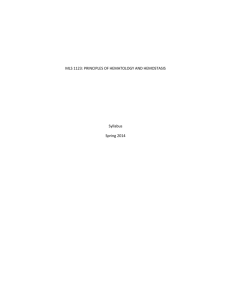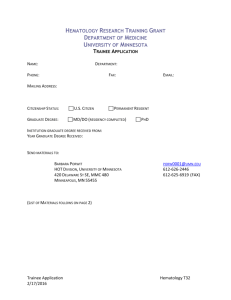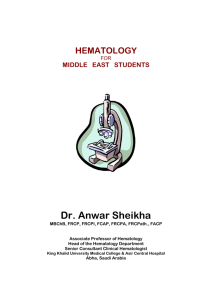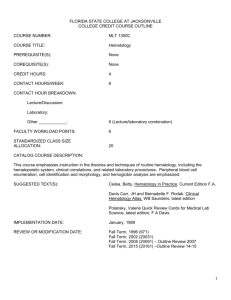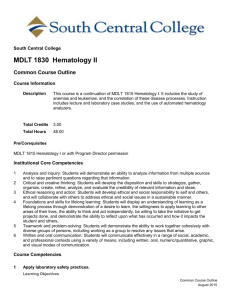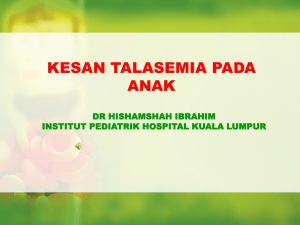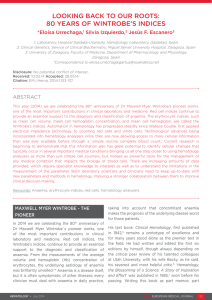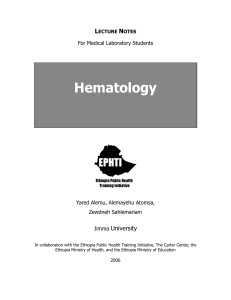University of Salahaddin-Erbil College of Science Department of
advertisement
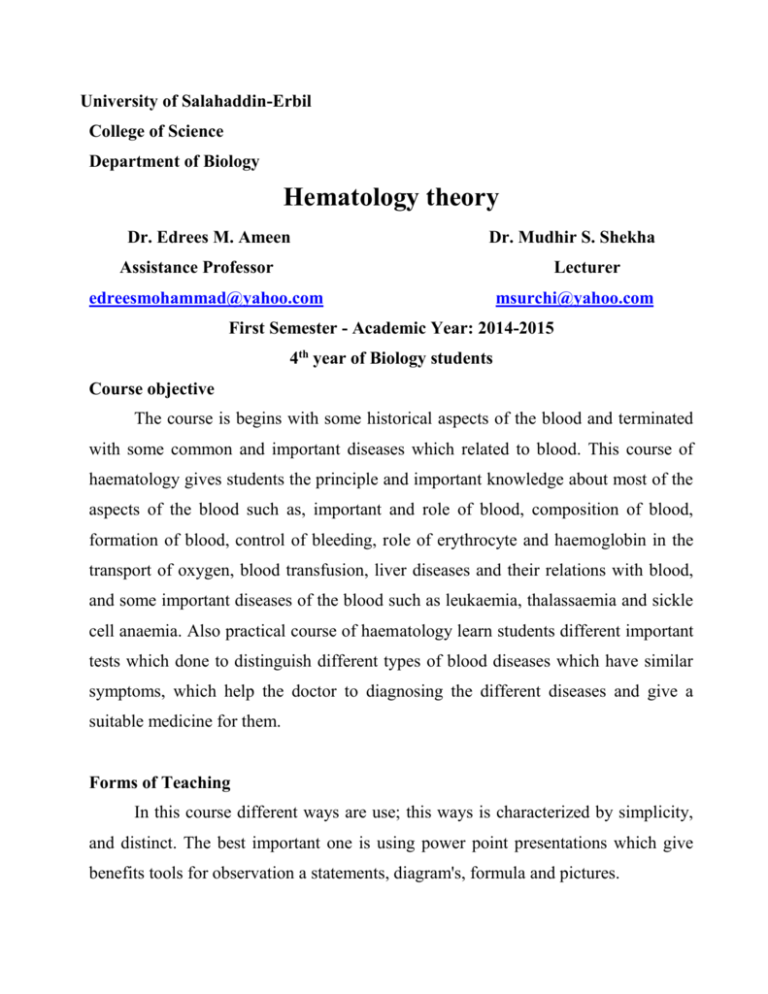
University of Salahaddin-Erbil College of Science Department of Biology Hematology theory Dr. Edrees M. Ameen Dr. Mudhir S. Shekha Assistance Professor Lecturer edreesmohammad@yahoo.com msurchi@yahoo.com First Semester - Academic Year: 2014-2015 4th year of Biology students Course objective The course is begins with some historical aspects of the blood and terminated with some common and important diseases which related to blood. This course of haematology gives students the principle and important knowledge about most of the aspects of the blood such as, important and role of blood, composition of blood, formation of blood, control of bleeding, role of erythrocyte and haemoglobin in the transport of oxygen, blood transfusion, liver diseases and their relations with blood, and some important diseases of the blood such as leukaemia, thalassaemia and sickle cell anaemia. Also practical course of haematology learn students different important tests which done to distinguish different types of blood diseases which have similar symptoms, which help the doctor to diagnosing the different diseases and give a suitable medicine for them. Forms of Teaching In this course different ways are use; this ways is characterized by simplicity, and distinct. The best important one is using power point presentations which give benefits tools for observation a statements, diagram's, formula and pictures. Grading Mean of two examinations: 12.5% Practical Examination 7.5% Final examination: 10% practical + 20 theory =30 References: 1- A–Z of Haematology by Barbara J. Bain and Rajeev Gupta, 2003 by Blackwell Publishing Ltd. 2- A beginners' guide to blood cells by Barbara J. Bain, 2nd Edition, 2004 by Blackwell Publishing Ltd. 3- Colour Atlas of Haematology Practical Microscopic and Clinical Diagnosis by Harald Theml, Heinz Diem, and Torsten Haferlach, 2nd revised edition, 2004, Thieme Stuttgart · New York. 4- Diagnostic Hematology by James A. Ker, 2009, Springer-Verlag London Limited. 5- Seely,R.R., Stephens, T.D. and Tate, P. (1998).Anatomy and physiology. Fourth edition, WCB McGraw – Hill. 6- Hematology, Basic Principles and Practice by Ronald Hoffman, Edward J. Benz, Sanford J. Shattil, Bruce Furie et al., Copyright © 2005, Elsevier Inc. 7- Haematolgy at a Galance. 2000. Atul B. Mehta and A. Victor Hoffbrand. BlackWell Science. 8- Hematology in Clinical Practice. 2005. Robert S. Hillman, Kenneth A. Ault and Henry M. Rinder. 4th Edition. McGraw-Hill. 9- Modern Hematology. 2007. Biology and clinical management. Reinhold Munker, Erhard Hiller, Jonathan Glass, and Ronald Paquette. Humana Press Inc. 10- PDQ Hematology. 2002. William F. Kern. BC Decker Inc 11- Williams Hematology. 2007. Marshall A. Lichtman. Ernest Beutler. Uri Seligsohn . Thomas J. Kipps and Kenneth Kaushansky. 7th edition. The McGrawHill Companies. The core materials of the course consists of the above book, articles from media and internet, and lecture’s notes, make sure you read all the materials and prepare well before going for the examinations Course program Week 1: Introduction, short history, role of blood, composition of blood. Week 2: Haematopoiesis, erythrocyte production, regulation of erythrocyte production, leucocytes production, platelets production. Week 3: Hemoglobin, structure and function, Transport of oxygen, Adjustment to the Metabolic Needs of Individual Tissues, Transport of Carbon Dioxide, Carbon Monoxide Poisoning. Week 4: Oxygen Delivery and Storage, myoglobin. Week 5: Erythrocyte destruction, The Fate of Expired Erythrocytes and Hemoglobin, Iron Metabolism, The Pathway of Iron Absorption, Transport, and Storage. Week 6: Hemostasis—The Control of Bleeding, Vascular Spasm, Platelet Plug Formation, Coagulation, Initiation of Coagulation, Completion of Coagulation. Week 7: 1st semester examination. Week 8: Blood Groups, Blood Typing and Blood Transfusions, The discovery of blood groups, ABO blood grouping system, Rh factor blood grouping system, Crossmatching, Hemolytic disease of newborn (HDN) or erythroblastosis fetalis, Blood Transfusions for Pets. Week 9: blood bank Week 10: Red blood Disorder Week 11: Leukocyte Disorder Week 12: Thalassemia, Alpha (α) thalassemias, Beta thalassemia, Signs and Symptoms of Thalassemias, Complications of Thalassemias, Thalassemias Diagnosed, Thalassemias Treatment. Week 13: 2nd semester examination Examples of Semester Examinations Q1: Define the following Carboxyhemoglobin, Myoglobin, Hemolysis, Biliverdin, Iron overload, Chronic leukemia, beta thalassemia, Polycythemia. Q2: Complete the following sentences with suitable words: 1- The process of blood cell production, called ---------------2- Each erythrocyte contains about---------------- Molecules of hemoglobin. 3-When hemoglobin is 100% saturated, every molecule of it carries -----------4- Blood transfusion is the process of receiving ---------------- into one's circulation intravenously. 5. --------------------------is the formation of a blood clot inside a blood vessel Q3: Explain the following: 1- The causes of hypoxemia. 2- Vascular spasm. 3- Secondary polycythemia 4. Process of Erythropoiesis (Diagram) Q4: Write the reasons of the following: 1- Warfarin (coumadin) prevents clot formation. 2-Platelets will not adhere to the endothelium of undamaged blood vessels. Q5: Draw and labels the following: 1- Effects of Temp and pH on oxyhemoglobin dissociation. 2- The life and death of erythrocytes. Q6 Multiple choice: 1. Which types of anaemia is occur in the absence of folic acid and intrinsic factor? a. Thalassaemia b. Iron deficiency anemia Hemolytic anemia c. Macrocytic anemia d. 2. Erythropoietin is a hormone responsible for the process--------------------? a. Leukopoiesis lymphopoiesis b. Thrombopoiesis c. Erythropoiesis d.. 3. ----------------------------- s a relative decrease of platelets in blood a. Thrombocytopenia b. Leukopenia c. anaemia d. neutropenia Q7: Answer the following questions "True" or "False" and Correct the false 1. Red blood cells are Bi-concave cell that no contain nucleus to easily moved through blood vessel. (F) 2. Beta thalassemia are due to mutations in the HBB gene on chromosome 11. (F) 3. The megakaryocyte is a bone marrow cell responsible for the production of blood Thrombocyte. (F) 4. Haemochromatosis characterized by excessive intestinal absorption of dietary iron resulting in a pathological increase in total body iron stores. (T) 5. Multiple myeloma is a cancer of plasma cells normally responsible for producing antibodies. (T)

